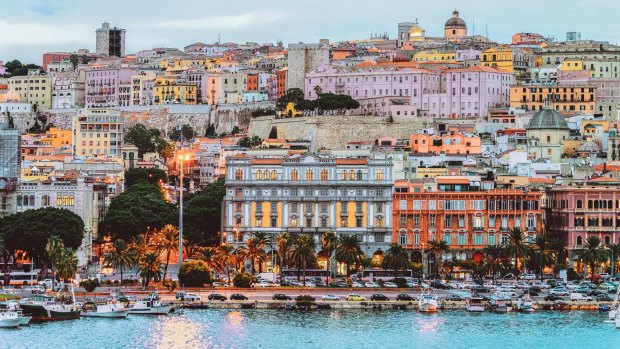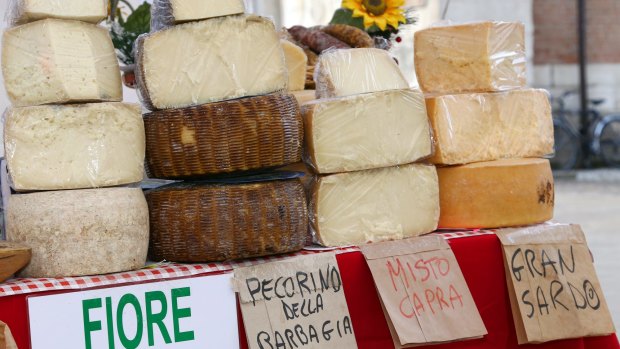This was published 1 year ago
Sardinia, Italy: How this Mediterranean island differentiates itself from mainland Italy

Sardinia's sometimes ostentatious wealth belies a stunning local food scene.Credit: RomanBabakin
We know we've made a mistake almost immediately. With an hour to kill before our dinner at Lucina, my friend Robbie and I decide to take a walk around Porto Cervo, the centre of affluence and glamour on Sardinia's Costa Smeralda. The wealth is almost unimaginable, the people so good-looking it is impossible to hold their beautiful gazes.
Around the marina, yachts worth several times what we'll earn in our entire lifetimes are anchored in formation, unknowingly participating in their own beauty contests. Most people are wearing white, the better to show off their deep tans, and shimmering jewellery to show off more generally. On a hill, overlooking the bay, is a newly arrived, ultra trendy franchise of Zuma. Of the many boutiques placed along the pier, one sells gym equipment. This seems out of place until Robbie guesses it is likely there to sell directly to the largest yachts. We are in Sardinia, but it feels like we are in the place Dubai imagines it is.
We haven't actually come for any of this ostentation, but instead to explore the island through its remarkable cuisine. Sardinia is technically an Italian territory, but with its own language, culture, and flag, it understandably regards itself as something other. An hour or so south from the extravagance of Porto Cervo, Simonetta Bazzu presents a very different side of her island. Operating in her family's 200-year-old home, she describes her hamlet of Battista as a "ghost town" as most of the young people have moved away.

The island has remarkable cuisine. Pictured: Sardinian cheese at the market.Credit: iStock
Just 38 and glamorous in a way that wouldn't be out of place up the coast, in recent years she has dedicated herself to encouraging visitors to appreciate Sardinian food, especially pasta. Her cooking courses are almost always full in the summer months, and come with a hint, if not a promise, of eternal life. "We live for a long time here, one of the Blue Zones is here on my island," she says, referring to Sardinia's uncommonly high percentage of centenarians. She credits making pasta, drinking red wine, and local, organic food as being keys to this remarkable longevity, but also "domestic work", focussing on the home and family, rather than chasing money in soulless city jobs.
Bazzu sounds genuinely thrilled when I tell her that our next stop will be in the centre of the island. "Oliena?" She asks, delighted, before squeezing herself as though I've just paid her a huge personal compliment. "You will love it. There is the real Sardinia."
Driving deeper into the interior, its mountainous belly provides a serrated horizon, a landscape that only gets more dramatic with proximity. Oliena is set like a jewel in this dramatic environment, a medieval city where outsiders aren't too common, but seem welcome all the same. The hospitality at Sa Corta is remarkable, despite both us and the waiting staff having to lean heavily on Google Translate to make the orders. The quality of the food is equally excellent, so good in fact that despite its relatively unfashionable location it has caught the eye of the Michelin Guide.
The cuisine here is wholly Sardinian, but the lamb meatballs and delicate raviolis are quite conservative compared to other traditional dishes. Elsewhere on the island, things can seem downright weird, no matter how authentic they are. One evening we find horse steaks on a menu, while in the airport – vacuum packed and ready to take home to a loved one – is callu de cabrettu, a cheese I last found in the Museum of Disgusting Food in Malmo. Made from milk contained in the stomach of a newly disembowelled baby goat, it tastes wonderful if you can get over its origin story. And that perhaps seems tame compared to casu martzu (also on the list in the Swedish museum), a pecorino which has been partly decomposed by the addition of insect larvae.
Things are on balance more reasonable in Sa Domu Sarda, one of the most popular Sardinian restaurants in Cagliari, the island's capital and only real city. Taking a seat in the cavernous restaurant, I seem to be one of the few non-locals dining – the menu is only in Italian and I find myself leaning on apps again to work out what's what. There's an excellent array of pastas and some genuinely appealing cheeses on the list, but as soon as I see it, I know I'll have to try the donkey meat and dried tomato stew.
When the waiter tells me it's already finished for the day, he does so with some classic Italian theatricality, looking so genuinely heartbroken on my behalf that I can't tell him I'm secretly a bit relieved to just order some ravioli instead.
The writer travelled at his own expense.
Sign up for the Traveller Deals newsletter
Get exclusive travel deals delivered straight to your inbox. Sign up now.